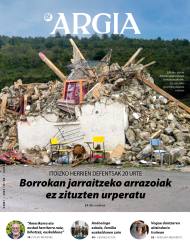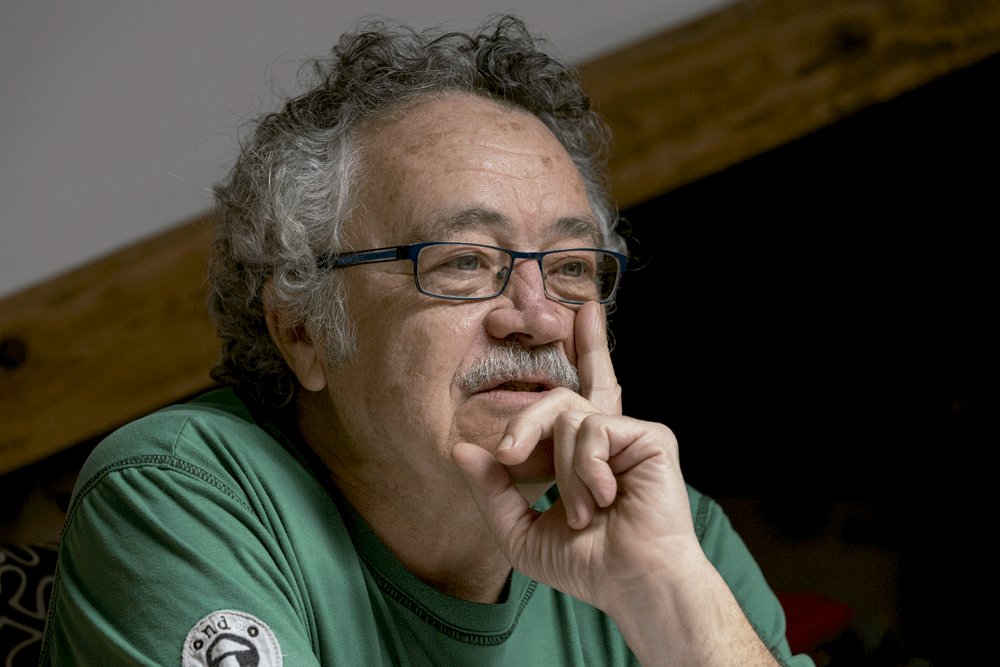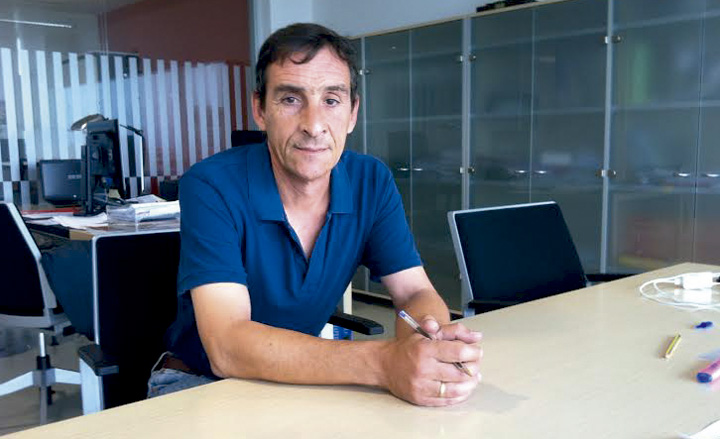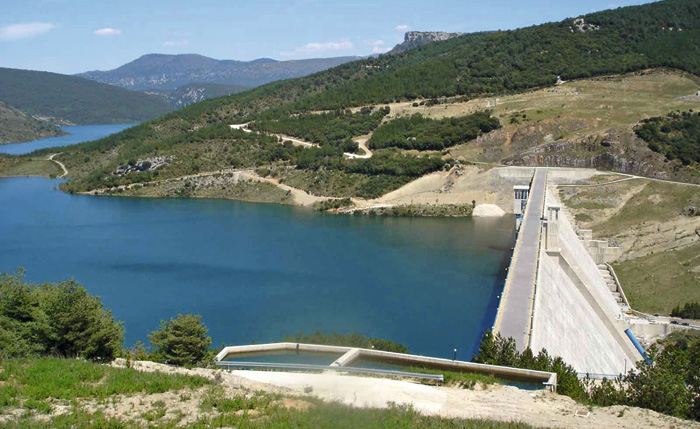Umbilical cord of suffocating gold
- The Itoiz reservoir was built to drive water to central and southern Navarra, mainly irrigation water, but also drinking and industrial water. And this was to be done through the Canal de Navarra, which with a giant 198 kilometer building would join the reservoir with the Ribera. This was the initial plan, according to the project agreed by the governments of Navarra and Spain in 1998.

The canal is divided into two sections: the first, 98 kilometres, runs from the Itoiz reservoir to Pitillas and has been in operation for some time. They were built in opencast 60 kilometers, fifteen in tunnels and 23 in siphons. It consists of three reservoirs and two branches: one from Añorbe to Mendigorría and the other between Tafalla and Olite. It has a irrigation area of 22,300 hectares. The work was completed in 2011 and then started in the second part. But the context at the time was not slow either, the economic crisis hit Navarra for the most part and the government was squeezing. Despite the funding problems, it could be thought that they existed today, but also that the project was not well studied. In any case, the fact is that construction work has not yet begun.
This is not the second phase, but the Yolanda Barcina government of the UPN presented by surprise the expansion of the first phase and in early 2015 began works with a 21 km canal for the transfer of water from Itoiz to the basins of the Ega and Arga rivers: On the land of Andosilla, Azagra, Berbinzana, Carcar, Falces, Funes, Larraga, Lerín, Lodosa, Mendigorría, Miranda de Arga, Oteiza, Peralta, San Adrián and Sesma 15,200 hectares may be irrigated. It's almost done. In many places, however, there have been major problems between traditional irrigation systems and the new one, and in Lerín, for example, in 2014 most of its farmers voted against the Canal de Navarra. In Cárcar, the Irrigation Board also did.
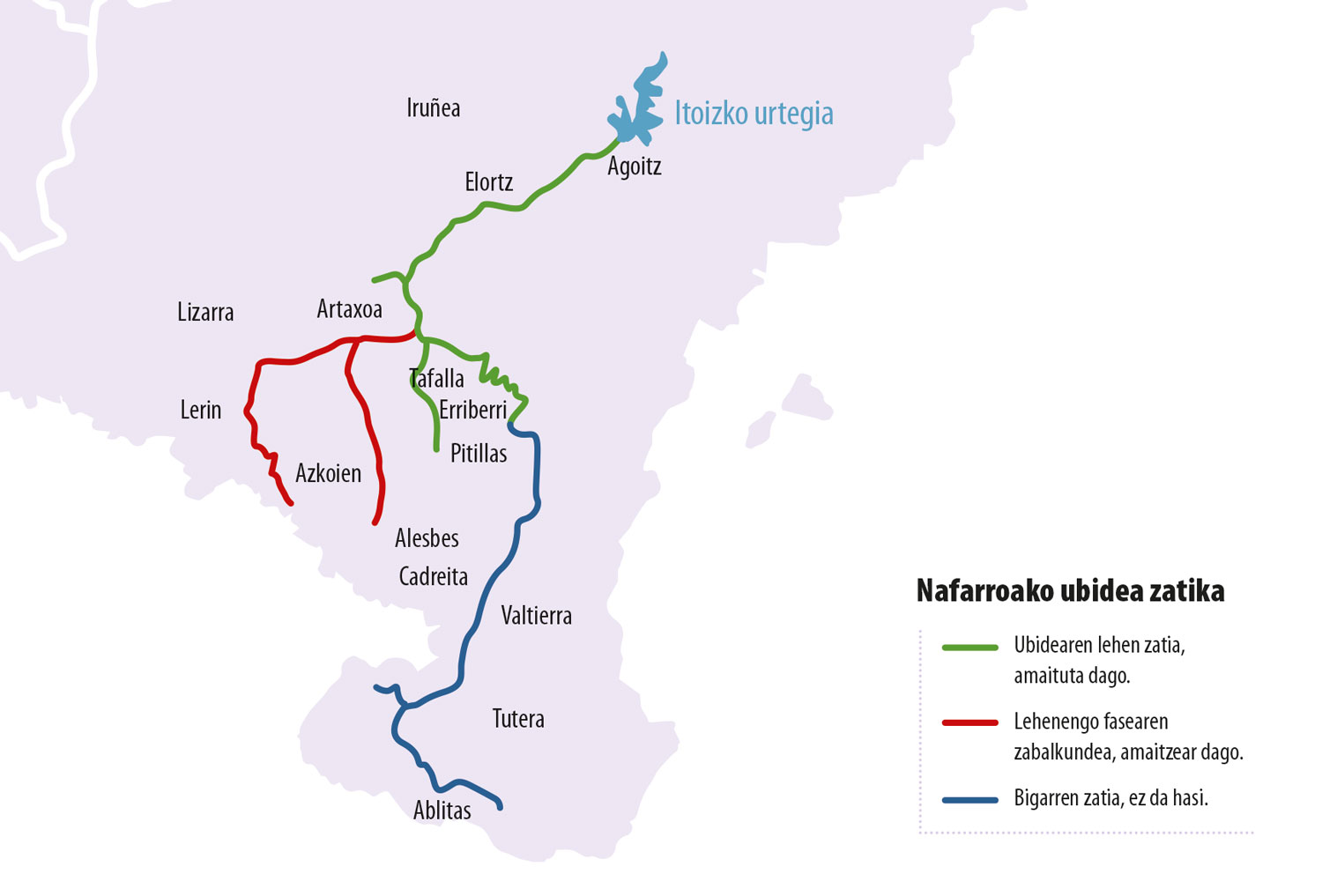
The project of the second section of the canal has 71.4 kilometers, the works have been announced again and again, and the president, María Chivite, has pointed out that the works will begin in 2024. From Pitillas to Ablitas, it wants to water 21,000 hectares of land on the left and right of the Ebro. The second section, initially opencast, will run as the first, but will finally be executed with buried steel pipes.
The reservoirs of Itoiz and the Canal de Navarra have brought their controversies since its inception, because in the dreams of the supporters will be indispensable for the development of the Navarre economy, and in the nightmare of the opponents, because they are devastating and economically unfeasible projects, among others.
When we are immersed in the climate change era, for the UPN and the PSN, which have been the drivers of the project, the canal will allow to bring to the Ribera the water that is increasingly smaller. On the contrary, detractors consider that in times when water is increasingly deficient, special care must be taken for this precious good, without squandering, as the managers of the river bed drive from their practices, the more it is watered, the cheaper the water. They even argue that this is no longer just a management or a concept, but also a physical problem, as there will not be enough water to water all the planned terrain.
.jpg)
Paying up to 2044
From Wikipedia you can read that the Itoiz dam and the Canal de Navarra have a budget of EUR 1.2 billion in fifteen years of investment. It is a lot, but it will be more, at least if the second section of the channel is carried out, thus becoming the largest and most expensive infrastructure built up so far in Navarra.
The two sections of the current stream have been paid with the formula of shaded tolls, such as the Pyrenees motorway and the Camino motorway. According to this, construction companies invest in construction and the foreign government pays them an agreed amount annually. According to the 2021 report of the Navarra House of Auditors on the canal, construction works have cost EUR 327.7 million, the cost overruns have been EUR 583 million, so so far both projects will absorb EUR 911.5 million, of which EUR 700,7 million are still to be paid. The first instalment of the channel has a payment period of between 2006 and 2032, and the extension of 2017 to 2044. Infrastructure management will then be returned to the hands of the Foral Government.
This amount does not take account of the second part of the channel with a budget of EUR 250 million, but if you look at the background you might think it will multiply at least. Without taking into account that this section is technically much more complex, as the stream runs through two highways, the Ebro, Aragon and Queiles rivers, among others. The forecasts indicate that half of these 250 million would be borne by the public construction company CANASA (60% Government of Navarra and 40% Spain) and the other half of the future regants.
But, according to the House of Auditors’ data, explaining this funding in this way has more to do with fantasy than with reality, as the amount of water consumed so far has been much lower than expected: 18% less in the first part and 68% less in its dissemination, especially in the latter due to the delay in the works. To date, the terms of the concession agreement have been agreed on five occasions, which have led to a 50% increase in the tariffs on the rails. This has been a great stir between the farmers and the water vendor, Aguacanasa. According to various studies, the infrastructure will in no way comply with its financing plan, and, as hitherto, the public treasury will have to take back the costs that do not correspond to it under the conventions.
.jpg)
Regarding plantations, Territorial Cohesion Advisor Bernardo Ciriza, relying on INTIA data, pointed out in 2020 that in the 2019 season maize was the most widespread crop on the canal grounds (49.4%). It is followed by horticultural (7.1%), solar (5.7%), tomato (5%), vine (3.1%) and olive (2.7%) plantations, among others. According to the INTIA 51 products have been planted in the first part and 44 in the dissemination. They also pointed out that in 2020 double harvests accounted for 15%.
In 1985 the Government of Navarra announced the Itoiz dam project. In 2023 the second part of the Navarre canal was released and in 2044 the last payment of the extension of the first tranche – shading toll – will be paid to CANASA. This precious and expensive drop of water from the Itoiz reservoir still has a long journey to Ablitas.
This report is sent to another: The resistance of subitoiz peoples turns 20
In this previously worked LARRUN, there is also more information on the subject: in the footprint of the channel sinking through Navarra
Ekainean jakinaraziko du Nafarroako Gobernuak Nafarroako ubidearen jarraipenak zein ibilbide eta hektarea kopuru izanen dituen. Orain kaleratutako bi txostenek 9.000 eta 10.000 hektarea inguru aurreikusi dituzten arren, nekazariekin kontrastatuko dute.
Ez da egingo Nafarroako ubidearen Bigarren Zatia (71 km, Pitillas-Ablitas), ez behintzat hasierako proiektuak aurreikusten zuen gisan, aire librean, Ebro eta Aragoi ibaik gainditzeko sifoi erraldoiak eginez eta ezaugarri konplexu haiekin.
1996ko apirilaren 6an Itoitzekin Elkartasuna taldeko zortzi kidek urtegiko obren kableak moztu eta presaren eraikuntza hainbat hilabetez gerarazi zuten. 20 urteren ondoren zero gunera itzuli gara.
Leringo herritarrek, lurren jabe diren heinean, Nafarroako Ubideko ura baliatzeari uko egin eta ureztatze sistema tradizionalarekin jarraitzea erabaki dute galdeketa lotesle bidez. Bozka eman duen herritarren %61 agertu dira aldaketaren kontra, "uraren pribatizazioa"... [+]
Nafarroako ubidearen bidez hegoaldeko lur ureztatuak gehitu nahi zituen Yolanda Barcina buru duen gobernuak. Ez dira ordea helburua lortzen ari, eta horren ordez atzo Mendinuetan 1.125 biztanlerengana edateko ura eramateko hartunea inauguratu zuten, Gara egunkariak ekarri... [+]









